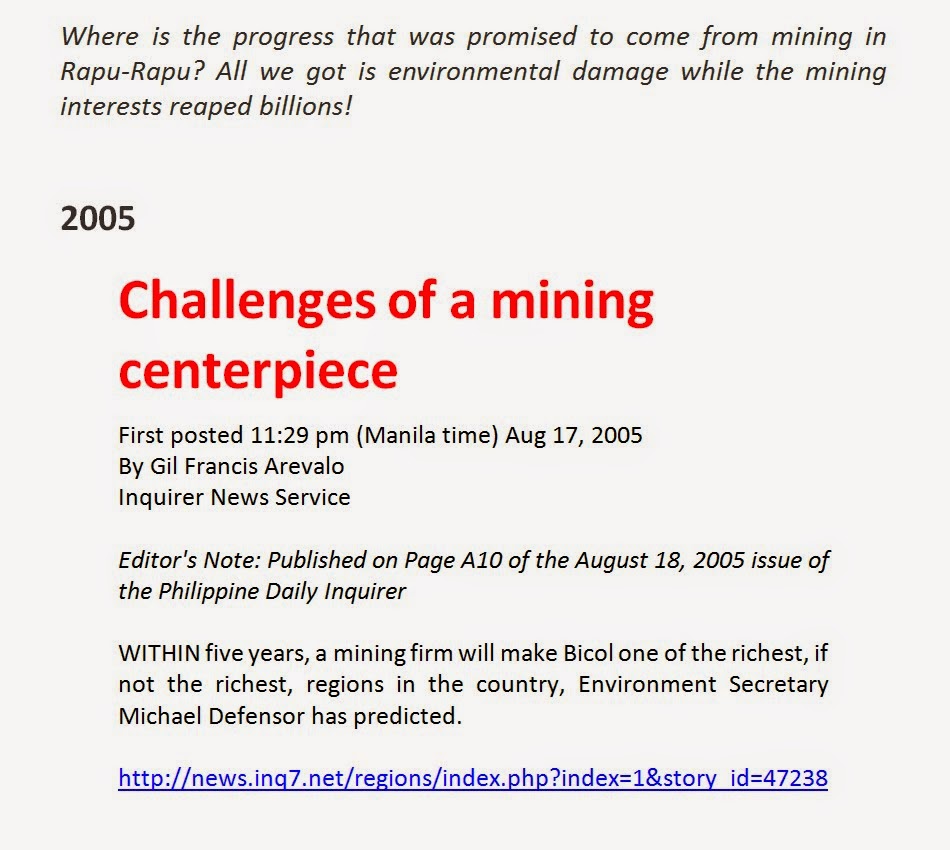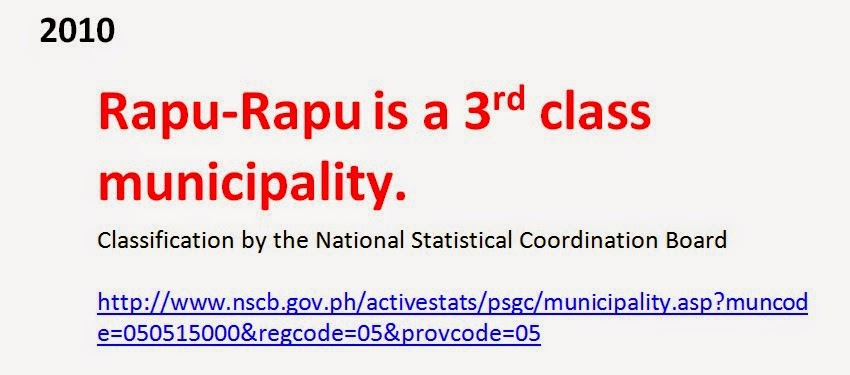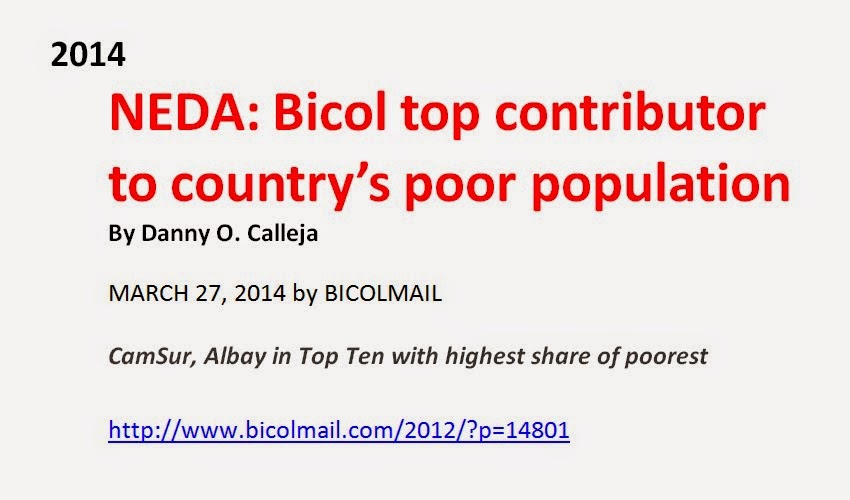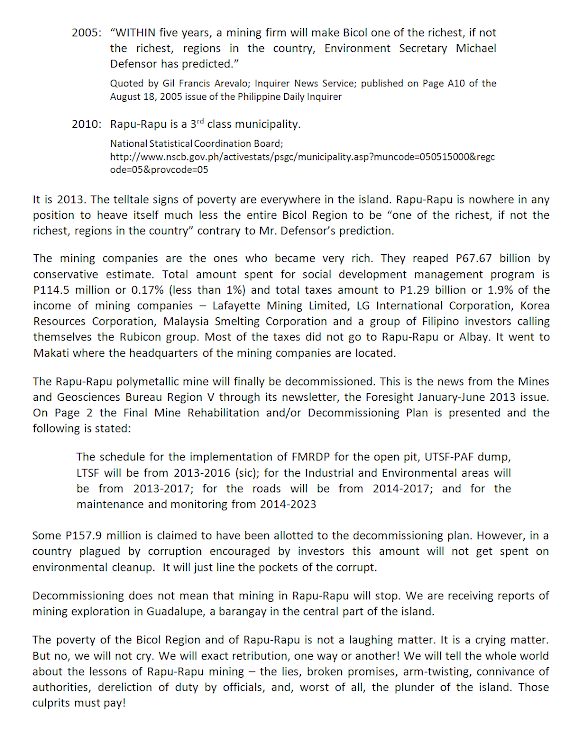The island of Rapu-Rapu in Albay, Philippines, is hostage to RRPP, formerly owned by Lafayette Mining Ltd of Australia, now taken over by LG & KORES of South Korea and MSC of Malaysia. Victim of compromised laws & corrupt government officials, the residents can only brace themselves for more ecological disasters & their effects: health problems, loss of land & livelihood, & uncertain future, UNLESS WE TAKE ACTION TO CLOSE THE RAPU-RAPU MINE.
RRPP Income from 2005 to 2012
RRPP Income in 2012
AND NOW THE END IS NEAR . . .
2
3
4
5
6
7
8
9
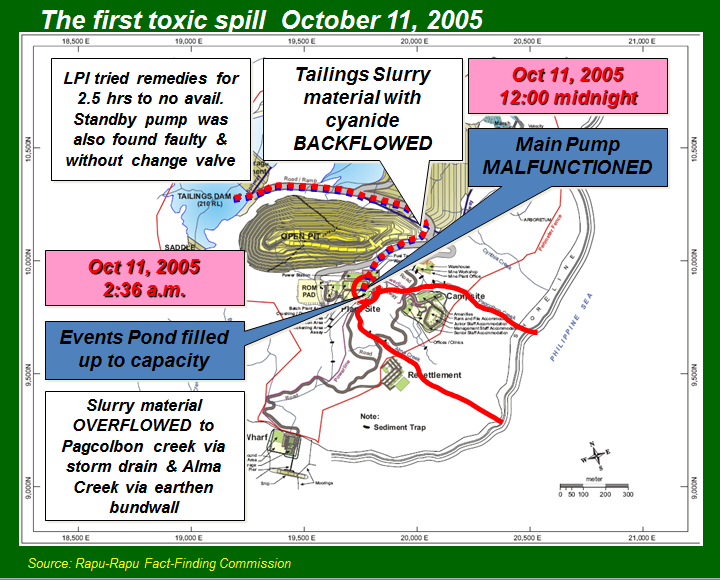
10
11
12
13
18
25
26
27
28
30
33
35
38
40
45
46
47
48
49
51
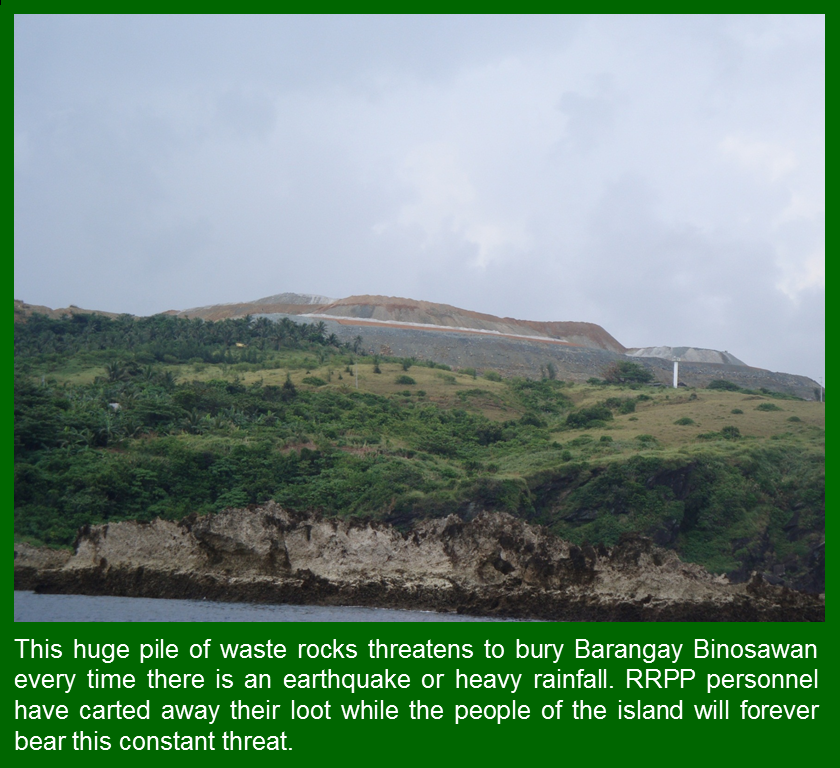
55
56
57
58
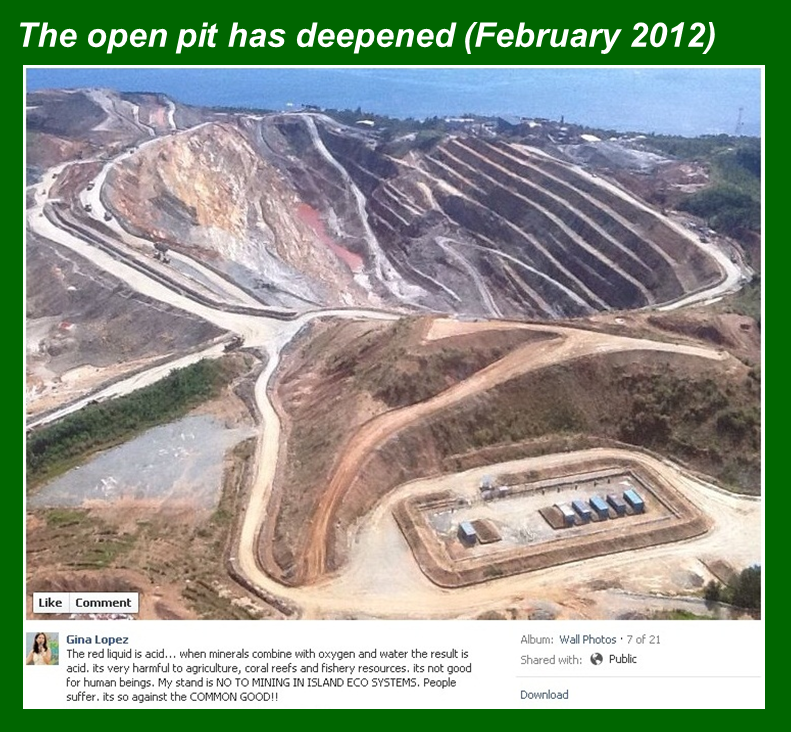
59
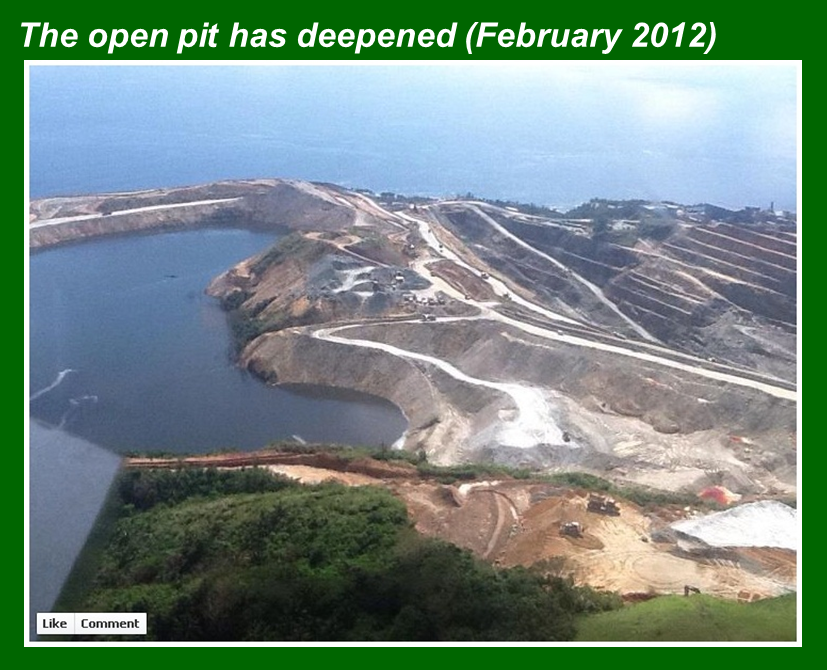
60 Finale

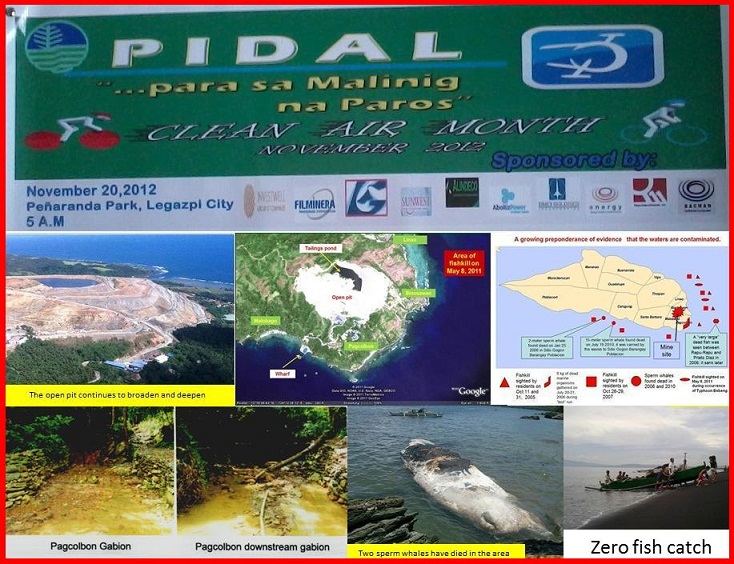




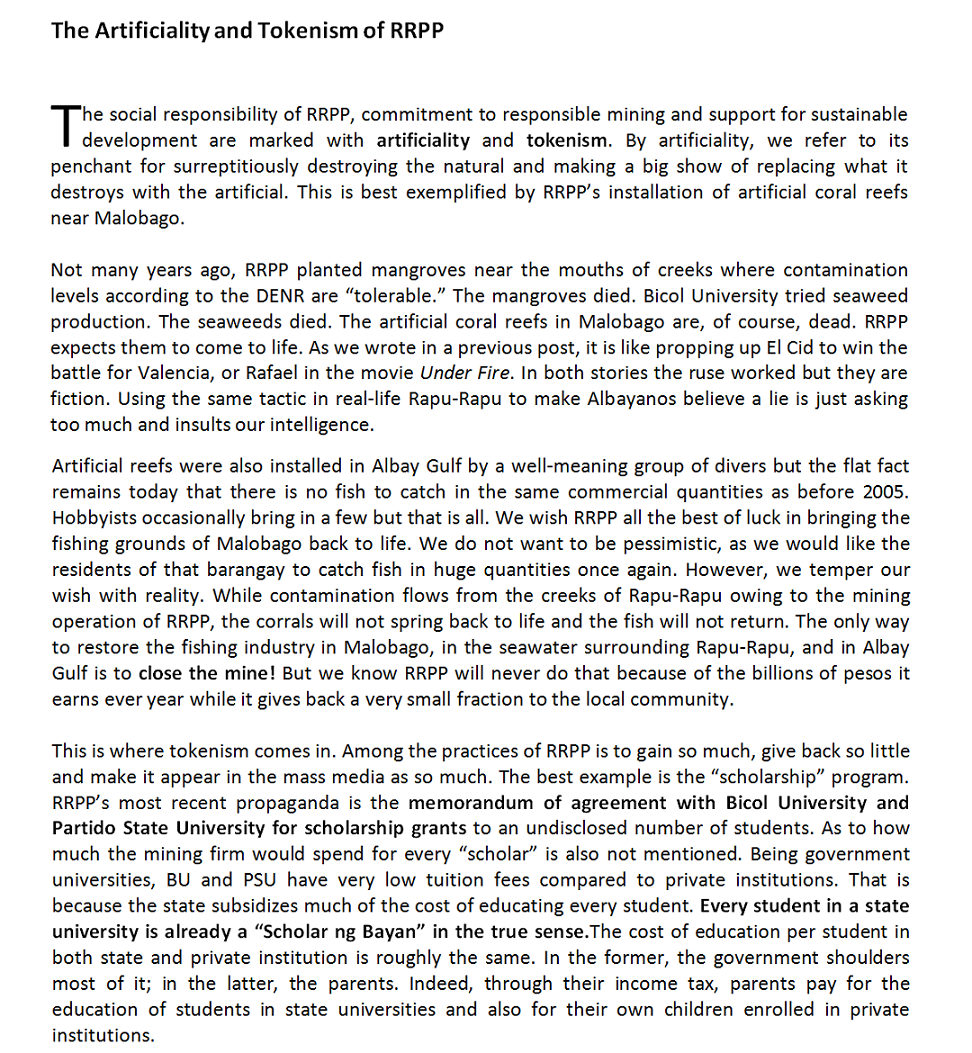

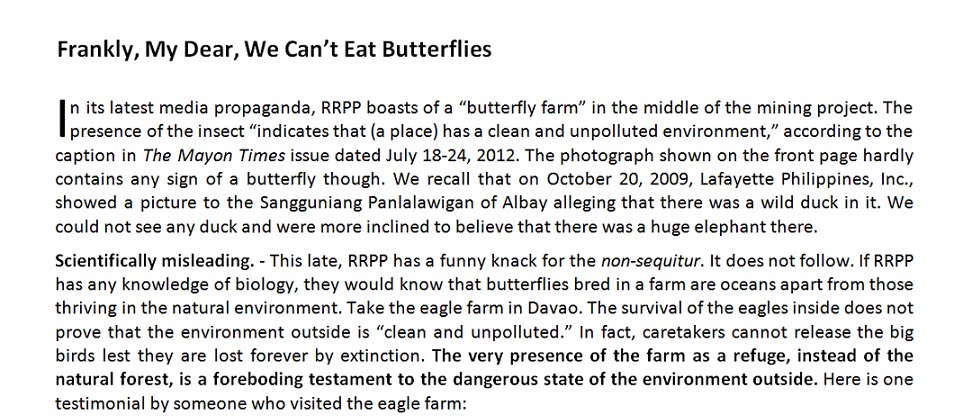


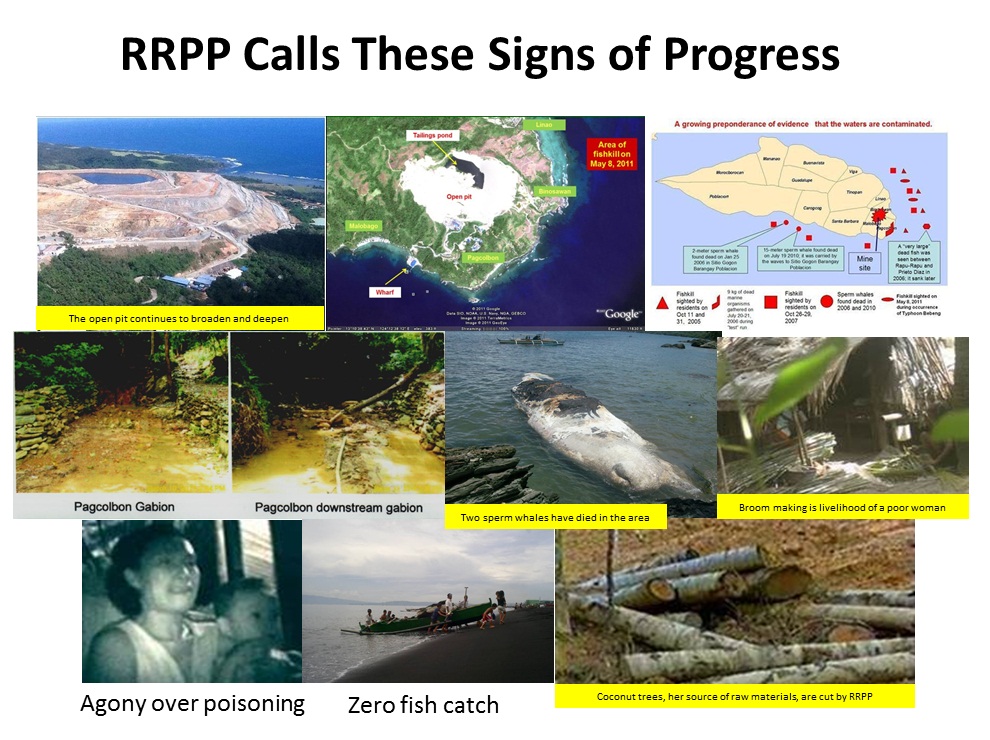



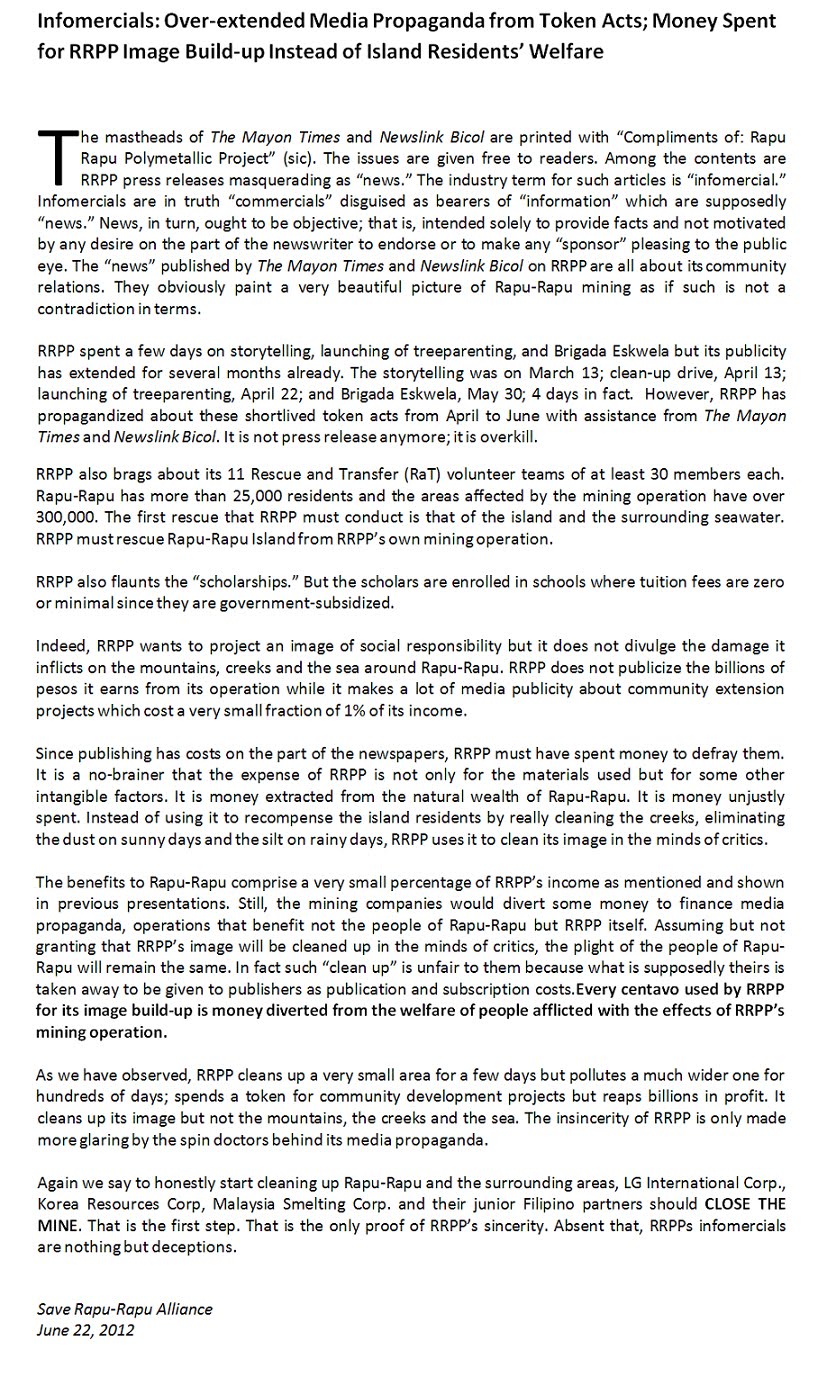


RRPP Income and Taxes in 2011

RRPP Income and Taxes in 2010
OPPOSE THE CONTINUING ONSLAUGHT ON THE EARTH
“I brought you into a fertile land to eat its fruit and rich produce. But you came and defiled my land and you made my inheritance detestable.” (Jeremiah 2:7)
We, the Ecumenical Bishops Forum (EBF), express alarm over the wanton abuse of natural resources by the Transnational Mining Corporations (TNCs) with their local cohorts in South Luzon Region, especially in Bicol. The experience of the Bicolano people is no different from the plight of local communities in mining areas throughout the country: massive environmental destruction, shrinking economic base of the people, militarization of mining communities, displacement of communities due to land-grabbing and unjust land-conversion, gross human rights violations, destruction of flora and fauna, and further impoverishment of the country. The unresolved and ever continuing polymetallic mining operations in Rapu-Rapu Island, Albay, Labo, Paracale, and Jose Panganiban, Camarines Norte, the aggressive mine expansion in Aroroy, Masbate by Filminera Resources Corp., the peculiar magnetite off-shore mining in Camarines Sur by Bogo Mining Resources Corp; the Palanog Cement Plant in Albay, Panganiban and San Andres, Catanduanes, and the deeper quagmire of maldevelopment of mining in Matnog, Sorsogon challenge us to rethink our role as responsible God’s stewards of creation ( Genesis 1: 26-31 ).
Destructive mining is blatantly unethical, unjust, and senseless for it exacerbates poverty, causes dislocation of livelihood of the people, and even threatens the base of life and life itself.
It is lamentable that the national government equates TNC mining with development, and is remiss in its duties in protecting the environment to the detriment of the people. It has been proven that the negative costs of mining operations far outweigh the gains.
Thus, to further liberalize the mining industry in favour of the mining corporations as being trumpeted by the Aquino administration will mean more suffering and death, dislocation, displacement and ruin of the environment.
Hence we call on the Filipino people:
1. To oppose all destructive mining operations, both locally or foreign-owned;
2. To scrap the Mining Act of 1995;
3. To demand immediate moratorium of large scale mining
4. To demand the demilitarization of mining communities
5. To fight for justice and integrity of creation;
6. To pass the HB 4315 or the Peoples’ Mining Bill
We urge our churches and faith-based groups and institutions to pursue organizing, awareness building, and other relevant activities, and be in full solidarity with the people’s movement against destructive mining operations.
With the liberating power of the Holy Spirit, we seek strength and wisdom to carry this task of asserting the right of the earth to survive and all that dwell therein.
Ecumenical Bishops Forum
October 6, 2011
DA Reports Rise in Fish Catch But Not in Albay Gulf
In the July 12-18, 2011 issue of Diario Veritas, the Department of Agriculture reported:
Nahilingan nin senyales nin pag-asenso an sector nin pagsisira sa paagi kan pagiging aktibo kan mga regional fishing ports sa primerong quarto kan taon.
Ipinahayag nin Rodolfo Paz, an general manager kan Philippine Fisheries Development Authority (PFDA), an mga dakop kan sira an nagtaas nin maabot sa 93 porsyento sa Navotas, Iloilo, asin Sual, Pangasinan.
Siring man an nanotaran sa Davao Fish Port Complex na nagkaigwa man na 40% na pagdakul nin dakop kumparadosa dakop kan mga parasira sa kaparehong peryodo kan nakaaging taon.
Katakod kaini, pinag-engganyar kan DA an gabos na local na gobyerno sa nasyon na pakusugon an industriya nina pagsisira partikular sa aspeto kan environmental protection asin pagbukod sa mga ilegal na mga parasira.
Nakaabot kaya an report sa DA na rampante an paggamit nin mga dinamitakan mga parasira sa nagkakapirang kostal na lugar kan nasyon kun saen saro kan naunambitan digdi iyo an rehiyon Bikol.
At least two points are implied in this report. First, there are rises in fish catch in several areas of the country but not in Albay Gulf. Second, the DA blames all declines in fish catch on environmental degradation “and” illegal fishing.
On the first implication: Why is there no report of any rise in fish catch in Albay Gulf? The answer is obvious: there is in fact a precipitous decline as attested to by fishermen. A 95% decline has been reported here since 2005 the same year when Lafayette went into full operation. Why is there such a decline? We have referred that question to the DA and its line bureau BFAR (Bureau of Fisheries and Aquatic Resources) but no answer has ever been given. (They have not even reported any investigation conducted on the cause of death of a 15-meter sperm whale in 2010.)
We have ascribed the decline to mining in Rapu-Rapu from which flow several creeks that are discolored. Officials of Rapu-Rapu Polymetallic Project reply that fish catch decline is a global phenomenon (technical meeting on April 26, 2011 in EMB). Now, we have here a rebuttal to that defense - the DA report of fish catch rise in at least four areas. Fish catch decline is not a global phenomenon.
On the second implication: Since DA reports rises in fish catch in four areas of the country and calls for curtailment of illegal fishing, then it follows that after curtailing illegal fishing we can observe a rise in fish catch. In Albay Gulf, the Bantay Dagat, a local watch group against illegal fishing, has been very active in this campaign. However, the fish catch decline continues. Couple this observation with the fact that the DA confirms the presence of a fish sanctuary in Gaba Bay, Villahermosa, Rapu-Rapu . With a fish sanctuary and active campaign against illegal fishing, fish population should increase within one or two seasons but this does not happen. Hence, illegal fishing cannot be the cause. Again, we are led to the more obvious – the mining operation in Rapu-Rapu.
It should be pointed out that much of the fish catch in the past according to fishermen consisted of migratory fish from the Pacific Ocean – yellowfin tuna, kwaw, malasugi, tanguigue, sharks, etc. These species do not need the local breeding grounds in Albay Gulf to multiply. They spawn in the areas around Guam and come to Albay Gulf to feed seasonally. They pass through the gap between Rapu-Rapu and Prieto Diaz following the current. Since 2005, the catch of these species has consistently declined. Something is barring their path in that gap and that something is none other than the contamination of silt and heavy metals flowing from the mine site through the creeks and ultimately to the waters around Rapu-Rapu. The current carries the contaminants into the Albay Gulf and spreads them as the tide flows back out into the Philippine Sea.
Any way we look at the phenomenon in Albay Gulf, the glaring fact is that mining has adversely affected our food supply. Between fishing where we derive 100% of the benefits and Rapu-Rapu mining where were derive only 1/3 of 1% (according to the statement of Gov. Joey Salceda in the Philippine Daily Inquirer on March 28, 2011), we have to choose the former.
The same issue of Diario Veritas banners the headline “City secures fish trade.” It reports the plan of the Legazpi City Council “to beef up the local fishing industry through stern legislation . . . Councilor Carlos Ante had already invited the different leaders of the local fisher folk to lay out details of a proposed ordinance to secure their livelihood.” I laud the efforts of the good councilor. However, I suggest that a more comprehensive view of the problem be taken if it is ever intended to be solved. As management theory suggests, any solution should address the real cause of the problem. Limiting the analysis within the immediate vicinity of the city’s coastal waters will lead to a failure at solution.
Not too long ago, we learned that several city councilors led by then Mayor Noel Rosal visited the Rapu-Rapu mine. In the newsletter of the Mines and Geosciences Bureau, Foresight, he was quoted as follows: “The mine is full of promise for the province” (Pages 9 and 11). I wrote Hon. Rosal in November 2010 (by then he had become the City Administrator) attaching photographs of the creeks colored brown, red, yellow and orange. I asked if the tour guides brought his group to the creeks. It’s September 2011 and I still have to receive a reply. I also wrote to MGB V and EMB V. Both replied that the contamination in the creeks is within “tolerable levels.”
RRMI, RRPI, LG, Kores and MSC should not think that they have succeeded in convincing the local community in their claim that the mine is operated responsibly and that the benefits they have derived translate to sustainable development of the people. The condition of the creeks, the fish catch decline and the poverty prevailing in the island all speak eloquently of the truth. Environmental damage and economic injustice have worsened. Adding insult to injury, they have praised themselves through press releases about their environmental awards while the residents of Rapu-Rapu and the fishermen of Albay Gulf continue to suffer. The contamination in the creeks may be within “tolerable levels” in the standards of the DENR but the poverty of the island residents, the fish catch decline and the environmental damage are definitely intolerable in the standards of the local community.
The DA, BFAR, DENR, Legazpi City Council, other local government units and other authorities better look into Rapu-Rapu mining honestly if they really want to solve the problem of fish catch decline in Albay Gulf. Anything less than that would not be in keeping with the public trust reposed in them.
September 4, 2011
Giving some; taking so much
Mining Engineers’ Conference in Legazpi City blind to local residents’ plight!
We remind the Provincial Government of Albay about the Sangguniang Panlalawigan Resolution 2011-020 issued on March 8, 2011 banning all future mining activities in the province. It should have shown consistency by expressing disfavor against the convention.
We rebuke the City Government of Legazpi for going against the sentiments of Albayanos against the continued destruction of our environment. The city has recently manifested its inability to walk the talk. In Mount Bariw, Barangay Estanza, a large swath of hillside is severely denuded yet it has done nothing. The silt from the denudation has flowed to Barangay Pinaric where it is several inches thick. In Embarcadero, large volumes of floating garbage greet the citizens whenever they go for a leisurely stroll along the boulevard. The city government has been so preoccupied with pleasing tourists but compromised the welfare of local residents who voted them into office and pay millions in taxes. Tourists bring in income but that income is just a means towards providing better living conditions for local residents. The means cannot be exchanged for the end. If the welfare of citizens is disadvantaged by the city government’s preoccupation with pleasing tourists, then it is time to withdraw the trust reposed in them during election.
The hosting of the mining engineers’ convention in Legazpi is a misstep of the city government. It betrays a failure to understand genuine environmental advocacy. While the city brags about its sanitary landfill, it fails to prove its pro-environment agenda by making a prominent endorsement of mining as a stimulant of progress. While we need products derived from mining, we insist that it should be done in the right place and the right manner. That is what responsible mining is all about. So far, however, all claims of responsible mining by many companies are nothing but hot air because of the evident damage wrought on their surroundings like what is happening in Rapu-Rapu, Aroroy, Palanog, Matnog, Paracale, Catanduanes, Caramoan, etc.
They say, if we do not want mining then we should not use the products of that industry. They are dead wrong. We want mining that does not destroy the environment. We want mining that reserves the natural resources of the Philippines for Filipinos. We want mining that spreads the fruits of development to the masses and not only to the foreign investors and their local junior partners.
We want mining that does not sacrifice our agriculture so that we protect our own food supply. Mining generally provides for non-basic needs while agriculture produces our most basic needs like food, clothing, shelter and livelihood. While mining generates a few temporary jobs, agriculture provides long-term sources of income thus genuinely assuring sustainable development.
We call on all mining engineers to support our notion of genuinely responsible mining. In view of the bad record of mining in Bicol, we ask them not to project the impression that they condone what is happening here contrary to declarations by the DENR, MGB, EMB and companies that all is well in Bicol mining. Bicol is severely suffering from the impacts of mining and the statements of the aforementioned entities are belied when we see the plight of the farmers and fishermen and the condition of our mountains, rivers, creeks and seas.
So in their visit to Rapu-Rapu today, they should make an objective assessment on the effects of mining in the island and its residents and not make it a mere field trip. They should talk to the people to know the real impact of RRPP on their lives. They tell us nothing but misery and deepening poverty. While the project heaps billions upon the foreign investors and their local junior partners, it brings “Lilliputian” benefits to the residents of the island and severe fish catch decline in Albay Gulf on which depend some 14,000 fishermen. Today, there is no more fish to catch in the gulf.
In 2010, the project earned P11.7 billion but according to Gov. Joey Salceda himself the province got a social fund of P41.71 million or a measly one-third (1/3) of 1%! If that is not enough, one can look at the creeks flowing from the mine site to the sea. They are colored yellow, orange, red and brown.
We ask the delegates to the mining conference to wake up to realities and not be deceived by the lies of those who support mining operations in Bicol.
July 19, 2011
RRPP’s Awards - Rubbing Salt on the People’s Injury
As the cliché goes, the proof of the pudding is in the eating. One needs only to go to the island and talk to the people to know the real impact of RRPP on their lives. They tell nothing but misery and deepening poverty. While the project heaps billions upon the foreign investors and their local junior partners, it brings “Lilliputian” benefits to the residents of the island and severe fish catch decline in Albay Gulf on which depend some 14,000 fishermen. Today, there is no more fish to catch in the gulf.
In 2010, the project earned P11.7 billion but according to Gov. Joey Salceda himself the province got a social fund of P41.71 million or a measly one-third (1/3) of 1%! If that is not enough, one can look at the creeks flowing from the mine site to the sea. They are colored yellow, orange, red and brown. Challenged to prove his belief in the reports of the Multi-partite Monitoring Team by bathing in the creeks on schedules and sites set by SARA, Director Reynulfo Juan of MGB V, showed photos of people perching on rocks in the discolored creeks on dates and sites they themselves chose. Challenged by SARA to withdraw the armed CAFGUs and allow free access and surprise visits to the creeks, Engr. Rogelio Corpus, President of RRMI, replied that they cannot allow such because they “have to protect their interests.” Hence, the interests of the environment and those of RRPP are contradictory.
The executives of RRPP can go on deluding themselves with fantastic claims of “safe and responsible mining” in Rapu-Rapu but the truth is well-known to the people who suffer much from the environmental damage and economic injustice attendant to the project. The emperor’s new clothes are well-praised by the award-giving bodies. One day, the truth will prevail and the awards will instead shatter their credibility. There is time under heaven for everything, says the Bible. Today, in the island of Rapu-Rapu and villages dependent on Albay Gulf, the people are groaning in pain. The awards are salt rubbed on their wounds while RRPP’s supporters have their photo-ops and raise their toasts of wine in fine dining. We believe that the day will come when, after being denied for so long, the people shall claim justice and RRPP’s awards will go to the dustbin.
July 18, 2011
Noon at Ngayon, Walang Responsableng Dayuhang Pagmimina sa Kabikolan!
Kahiya-hiya at malakas pa ang loob na ang itinakdang tema ng kumperensyang magaganap ay: Towards Responsible Mining: “Against All Odds”. Responsable para kanino? - Para sa mga malalaki at dayuhang korporasyon sa pagmimina kasama ng mga malalaking lokal na negosyante at para sa mga matataas na opisyales ng gobyerno at ahensya na nakikipagsabwatan sa mga korporasyong ito.
Kalokohang sabihin na ang operasyon na Open Pit Mining sa Rapu-Rapu, Albay (Rapu-Rapu Polymetallic Project ng Lafayette/LG-Kollins) at sa Aroroy, Masbate (Masbate Gold Project ng Filminera Resources Corporation) ay responsable! Mayroon bang pagpapasabog (blasting) ng kabundukan at kalupaan na “safe and environmental friendly”? Samantalang winawasak nga at hinuhukay pailalim.
Hindi rin responsable ang Magnetite Offshore Mining ng Bogo Mining Resources Corp. sa limang bayan ng Calabanga, Sipocot, Tinambac, Cabusao at Siruma sa Camarines Sur kung saan hahalukayin ang kailaliman ng karagatan 15 kilometro mula sa baybayin nito.
Hindi kailanman naging responsable ang mga dayuhang korporasyon ng pagmimina sa mga naapektuhan ng kanilang mga operasyon. Simula ng operasyon ng RRPP sa Rapu-Rapu ay lalong lumala ang kahirapan at nagkagutom-gutom ang mga residente dito dahil sa pagbagsak ng kanilang kabuhayan sa pangingisda at pagsasaka dulot ng mga lason ng pagmimina dito. Kung mayroong nakinabang sa binayad ng RRPP na P10,862.85 (mine waste fee) para sa 217,257 tonelada na “mine waste” ay ang MGB-V. (mula sa ulat ng MGB-V,2010). Sampung libong piso! Katumbas ba ito ng isang buhay ng nanay na namatay dahil nakakain ng isda dahil sa fishkill doon o ng isang batang namatay doon dahil sa kagutuman?
Apektado na nga ang mga residente sa pagmimina sa Barangay Nakalaya, Jose Panganiban sa Camarines Norte ay naiipit pa sila ngayon sa kaguluhan at away ng Investwell Corporation at ng FMCGI ng pamilyang Fonacier na nag-aagawan ng yamang mineral ng kanilang lugar.
Kasinungalingang ipamaglaki pa sa ulat ng DENR-V/MGB-V na ang malakihang pagmimina sa Kabikolan ang nagpasigla ng ekonomiya ng rehiyon samantalang ayon sa ulat ay nasa ikalawa sa pinakamahirap na rehiyon ang Bikol sa buong bansa. Kung sinasabi na umunlad ang ekonomiya ng Bikol dahil sa malakihang pagmimina – hindi ito maramdaman ng mga mamamayang Bikolano lalo na ng mga apektado ng mapaminsala at dayuhang pagmimina.
Tanging ang mga malalaki at dayuhang korporasyon sa pagmimina kasama ng mga malalaking lokal na negosyante at mga matataas na opisyales ng gobyerno at ahensya na nakikipagsabwatan sa mga korporasyong ito ang nakikinabang sa mga produkto at kita ng pagmimina dito sa Bikol. Sa ulat ng MBG-V/DENR-V noong 2010, sa kabuuan ay may P4,654,818,424.31 at P57,483,032.45 na kita mula sa “metallic ” at “non-metallic production”dito sa Bikol ayon sa pagkasunod-sunod ngunit hindi naman inulat ang mga dambuhala at limpak na limpak na kita ng mga korporasyon na maluwag na inilalabas patungo sa kanilang bansa. Maluwag nang nailalabas ang kita, maluwag pa ang kanilang operasyon dahil sa mga iba’t-ibang insentibo tulad ng: 6 years income tax exemption, 10 years export tax exemption, and import tax exemption at marami pang iba.
Kaya nga parang parang kabuteng nagsulputan ang mga ito sa Bikol dahil sa pagiging sagana ng rehiyon sa yamang mineral at prayoridad pa ng nakaraang gobyerno ni GMA ito para sa malakihang proyektong pagmimina na ipinagpapatuloy lamang ng gobyerno ni Noynoy Aquino at pinasahol pa sa ilalim ng kanyang Public-Private Partnership Program. Gayundin, patuloy ang pag-iral ng Mining Act of 1995 kung saan ay lalong nagbuyangyang sa ating likas na yaman para dambungin at wasakin ang ating kalikasan.
“Towards Responsible Mining: Against All Odds” ? - Ang responsableng pagmimina ay mangyayari lamang sa ating bansa kung magkakaroon ng re-oryentasyon ang industriya ng pagmimina sa ating bansa. Kung saan, ang kita ng industriya ng pagmimina ay napapakinabangan at napapaunlad ang mamamayang Pilipino at hindi napupunta sa dayuhan at sa mga lokal na kasabwat nito. Kung saan, ang gobyerno ang may kontrol ng industriya at hindi ang mga dayuhan.
Hindi dayuhang pagmimina at malawakang kumbersyon ng lupa ang magpapaunlad sa Kabikolan. Hindi ito ang sagot sa kahirapan at kagutuman ng mamamayang Bikolano. Pagpapaunlad ng agrikultura, trabaho at sapat na sahod, tirahan, libreng serbisyo-sosyal ang tutugon sa kahirapan at kagutuman upang mabuhay ng maayos at marangal ang mamamayang Bikolano. Tunay na Reporma sa Lupa at Pambansang Industriyalisasyon lamang ang magpapaunlad sa bansa at rehiyon.
UMALPAS-KA
Hulyo 13, 2011
A Word of Caution
Matthew 7:16 - You will know them by what they do. Thorn bushes do not bear grapes, and briers do not bear figs.
Matthew 7:20 - So then, you will know the false prophets by what they do.
The creeks are crucial to the condition of fishing grounds
The joke is that there will no longer be any fishkill - because there are no more fish to kill.
The fish that allegedly died off the coasts of Linao and Binosawan during the fishkill reported by island residents and the parish on May 8, 2011 could be the migratory species from the Pacific Ocean attempting to enter Albay Gulf via the gap between Rapu-Rapu and Prieto Diaz. Linao is a village facing the ocean and Binosawan, the gap.
The MGB V Photographs and "Bathing" in the Creeks of Rapu-Rapu
"With reference to your challenge to take a bath in the creeks, we have done just that. some members of the MMT and personnel of Rapu-Rapu Polymetallic Project (RRPP) went to a picnic and took a bath at Pagcolbon Creek on March 29 and April 3, 2011. We are attaching pictures for your reference. These pictures indicate the current status of the creeks."
In reply, Mr. Perdigon writes:
The good Director says he believes the contamination data but he is not among those “bathing.” Someone is shown sitting on the rocks (obviously not bathing) but the face is not recognizable (number 10).
01
02
03
04
05
06
07
08
09
10
11
Then and Now: What Difference? What Improvement in the Creeks?
Below, we are presenting ALL pictures in the Annex to the EMB V Investigation Report dated March 8-10, 2011. Those on the left are the pictures we have been showing to authorities which were taken from 2006 to 2009; those on the right are alleged to have been taken in the same spots on March 8 to 10, 2011 by EMB V and the mining companies. You be the judge if there is any improvement.
Pagcolbon gabion
Pagcolbon downstream gabion
Pagcolbon downstream
Pagcolbon downstream looking towards the sea
Pagcolbon shoreline
Pagcolbon downstream
Pagcolbon shoreline
Hollowstone downstream
Hollowstone shoreline
Maypajo shoreline
Saturday, February 20, 2010
A Fishy Tale or Can the Fish Tell?
Those who have eyes must see the truth. Those who have brains need only little effort to realize what is happening around Rapu-Rapu. If certain persons with authority to reverse the down slide would instead pretend not to see empirical data, then that is the problem. That is, indeed, the fishy situation.
Monday, February 15, 2010
Let us not forget the threat of Coal Mining in Rapu-Rapu
Now, the DENR is complaining that while they are perennially on the hot seat in Rapu-Rapu, the DOE which handles coal mining operations could very well afford to be silent on the issue. The DENR has a point to some extent. Still, you could not overly use -- and expect to get away with it -- the lame excuse that you are just following orders from above.
DOE, it's about time you tell the public the the extent of the coal mining operations in Batan and Rapu-Rapu, and your involvement in them.
.......
Rock Energy International Corporation
Our Company is engaged in coal trading operations and we are looking for highly competitive professionals to be part of the team.
Mining Engineer
Requirements
* Candidate must possess at least a Bachelor's/College Degree in Mining Engineering.
* Preferably with professional license.
* Must be computer literate; knowledge with autocad application is an advantage.
* Preferred languages: Filipino, English
* At least 1 year work experience in the field of mining.
* Preferably 2 years experience specializing in Geology/Geophysics.
* Fresh graduates are welcome to apply.
* Applicants should be Filipino citizens.
* Applicant must be willing to work in Liguan, Rapu-rapu, Albay
* Full-Time position available.
“GOOD COMPENSATION PACKAGE AND OTHER FRINGE BENEFITS AWAITS FOR THOSE WHO WILL QUALIFY”
If you wish to apply for the above position, you may send your resume in word format at recruitment@velcoasia.com or apply in person at G/F Mary Bachrach Bldg. 25th Corner Railroad St. Port Area, Manila
Telephone: 5277070 Fax: 5277373
Interested applicants may also apply in our office at Brgy. Liguan Rapu-rapu, Albay.
Look for Ms. Jenny Roa.
Interested applicants may apply online by clicking on the quick apply button
MGB Bicol bares accomplishments for 2009
MGB Bicol may harp its checklist accomplishments but it could never shake off its image as Lafayette/RRMI handlers. Consider what they have done to Rapu-Rapu:
1. The MGB turned the much publicized 2006 test run (Angelo Reyes: "You fail it, I close it".) into a tutorial run, going out of the way to make sure the mining firm pass the so-called test.
2. The company "failed" in many respects during the much publicized 2006 test run. The volume of polluting mineral contents in bodies of water surrounding the mine was found to be off the charts. A fish kill happened in July 2007, in the middle of the test run. Yet MGB declared the company to have passed the test on the strength of a highly questionable "expert" opinion. An opinion that was roundly & soundly criticized by the expert's former mentor.
3. What Multipartite Monitoring Team is MGB talking about in Rapu-Rapu when credible stakeholders shun membership in the much-distrusted MMT?
4. We still could not forget how the MGB whitewashed the investigation as to the cause of the 2007 fish kill in Rapu-Rapu, how they suppressed evidence, how they would not explain their findings to the public. We never heard about the final repot of the investigation after their anomalous initial report that was made public via the Albay Provincial Board.
5. MGB's main task in Rapu-Rapu is to help ensure the continued operations of the mine. It trumpets its accomplishments at the expense of the environment.
6. Most likely MGB will include its endorsing RRMI's mining exploration of Poblacion and Morocborocan among their accomplishment for 2010. Can't you see it? It is already Poblacion we are talking about, the center of the island, where practically everybody resists the mine and where pro-mining politicians don't win in the elections.
We simply cannot buy your "we are just doing our job" line. There ought to be more to your being public servants than simply signing papers following a checklist.
MGB RO V, if you disagree with our conclusions, we would love to hear your side. But please do not use the perennial lame excuse: "We are just following orders from above."
.......
MGB Bicol bares accomplishments for 2009
Legazpi City (11 February) -- The Mines and Geosciences Bureau (MGB) in Bicol has disclosed Monday (February 8) its major accomplishments for calendar year 2009 ensuring safety, health and environmental commitments of mining industry and measures to mitigate the implication of geologic hazards.
Engr. Reynulfo Juan, MGB Bicol regional director, told PIA News service that the agency has successful organized a total of 15 Capacity-Building Seminars of Geologic Hazard Awareness and Disaster Preparedness in the municipalities of Bulan, Sta. Magdalena, Matnog, Prieto Diaz and Castilla in Sorsogon; Pili, Ocampo and Tigaon in Camarines Sur; and Rapu-Rapu, Sto. Domingo, Bacacay, Malilipot, Tiwi, Tabaco City and Malinao in Albay.
During said seminars, local disaster manager and residents as well were briefed on the concept of geologic hazards, occurrence, areas prone to these hazards, reading and interpreting geo-hazard maps.
Juan said that the stakeholders were given information on how they could make use of the maps for preparedness planning, how to prepare and what to do during the occurrence of geologic hazards like flood and landslide.
MGB Bicol also distributed posters and flyers on flood and landslides hazards, geo-hazard maps with corresponding risk reduction, preparedness and mitigation measures
The bureau also turned over DVDs containing motion pictures on Living with Geologic Hazards and Community Based Flood Early Warning System.
A total of 408 barangays and 1,213 participants benefited from the capacity building seminar.
The bureau spearheaded Geo-hazard Identification Surveys to at least five subdivision/land development projects in Albay, Camarines Norte and Camarines Sur.
The bureau also had detailed investigation of areas threatened by landslides and other geologic hazards in Casiguran, Magallanes and Bacon in Sorsogon and in Bato, Catanduanes.
On mining, MGB Bicol regularly monitored the safety, health and environmental commitments of three active large-scale mines in the region, namely Ibalong Resources and Development Corporation, Rapu-Rapu Minerals Incorporated and Filminera Resources Corporation.
It investigated and resolved a total of 12 complaints, cases and conflicts involving illegal treasure hunting in Mt. Isarog National Park and Pacol in Naga City, all in Camarines Sur; seizure of MV Tina by the Esperanza (Masbate) Municipal Bantay Dagat Task Force suspected to be loaded with sand materials; alleged illegal magnetite sand extraction in the municipalities of Bulusan, Magallanes and Gubat including the reported extraction in Matnog, all in Sorsogon; against mining operation of Uni-Dragon Mining Corporation in Camarines Norte; alleged illegal small-scale mining within the watershed area in Jose Panganiban, Camarines Norte; alleged mining activities in Libmanan, Camarines Sur; alleged siltation caused by Konka-Fulim Mining and Development Corporation in Paracale, Camarines Norte; and alleged extraction of Ara-al (dimension stones) in Sangay, Albay.
At least 25 mining rights or permits holders, including Rapu-Rapu Minerals Incorporated, Trans-Asia, Masbate Phils. Incorporated, Filminera Resources Corporation, Johnson Gold Mining Corporation, United Paragon Mining Corporation, Uni-Dragon, OroPhil and Nena Pimentel were validated to ensure compliance to policies of activities undertaken within the area of their operation.
The bureau also monitored the compliance to safety, health, environment and social programs during exploration, development and operation stage of Ibalong Resources and Development Corporation in Camalig, Albay; Rapu-Rapu Minerals Incorporated in Rapu-Rapu, Albay; UBS Marketing Corporation in Legazpi City and Filminera Resources Corporation in Masbate.
Lastly, MGB Bicol implemented measures to strengthen the Multi-Partite Monitoring Teams (MMTs) for Ibalong Resources and Development Corporation (IRDC) in Palanog, Camalig, Albay; Rapu-Rapu Polymetallic Project in Rapu-Rapu, Albay and Filminera Resources Corporation in Masbate to monitor these mining companies' environmental and social commitments. (MGB V/PIA)
Thursday, February 11, 2010
Social Action Center - Diocese of Legazpi statement opposing RRMI application for expansion ot its mining exploration
Regional Executive Director
Department of Environment and Natural Resources
Region V, Regional Center Site, DENR V
Rawis, Legazpi City
STATEMENT OF SUPPORT TO THE OPPOSITION OF THE APPLICATION FOR EXPANSION OF THE MINING EXPLORATION
We strongly support the sentiments of the community in voicing their opposition against the application for expansion of mining exploration in the barangays of Poblacion and Morocborocan in the municipality of Rapu-Rapu, Albay. As experienced in the past, there were already violations committed by the Company and yet, were not given enough sanctions to merit such violations.
And now, application for such is being submitted to your good office weighing the benefits it has provided to the community as well as the destruction and deprivation it has incurred in the community, it has been found wanting.
The government’s drive to mitigate climate change in the province among its guidelines is contained in its Ten Commandments on Climate Change, expressed in the seventh commandment which says, “No to open pit mining”. Mining operations in Rapu-Rapu contradicts this very commandment and continuing to allow its operation makes us voiceless and toothless in order to punish this violators.
The general experience of the mining industry in the Philippines has never benefited areas from the mining operations. In fact, it has contributed to the worsening of economic and environmental condition. Allowing the further expansion of the mining exploration will only contribute to the ill effects of mining operations in the whole country.
We, the Social Action Center-Diocese of Legazpi would want to express our strong opposition against the said application of Rapu-Rapu Minerals, Inc.
Let us hear the voices of the little ones who are the greatest victims of this operation rather than protect the wealthy and the powerful who amassed the wealth of the poor.
(signed)
Rev. Fr. Ramoncito S. Segubiense
Executive Director
4 February 2010
Social Action Center-Diocese of Legazpi
Cathedral Compound, Albay District, Legazpi City
Resolution of Lagsingan Tribal Council in Rapu-Rapu condemning the MGB endorsement of the RRMI application for mining exploration in 2 barangays
National Commission for Indigenous Peoples Registered
Sitio Lagsingan, Barangay Poblacion, Rapu-Rapu, Albay
Hale sa minutos kan biglaan na ginibong hororon kan Lagsingan Tribal Council kan petsa 11 kan Enero alas 4:00 an hapon sa Sitio Lagsingan, Poblacion, Rapu-Rapu, Albay.
Resolusyon kan Lagsingan Tribal Council
Blg. 001, Serye 2010
RESOLUSYON SA PAGKONDENAR ASIN PAGKONTRA SA BAKO MAKATAWONG PAG-ENDORSAR KAN MINES AND GEOSCIENCES BUREAU SA PAAGI NI REGIONAL DIRECTOR REYNULFO A. JUAN SA OPISINA KAN RAPU-RAPU, ALBAY KAN NAKAAGING PETSA 5 KAN PEBRERO 2010 MANONGOD DAA SA NOTICE OF APPLICATION KAN KUMPANYANG RAPU-RAPU MINERALS INC. (RRMI) EXPA 000080-V PARA SA EXPLORATION PERMIT SA BARANGAY POBLACION BUDA BARANGAY MOROCBOROCAN TANGANING MINAHON AN KABUBULDAN NA SAKOP KAN MGA NASABING BARANGAY
Proponent: Lagsingan Tribal Community
NA, an mga nasabing barangay igwa ki nakaistar na nagtitios na mga tawo asin tribu na an ikinabubuhay hale sa dagat asin kabubuldan, buda an tubig na samong pig-iinom hale sa kabubuldan na samong pig-iistaran. An mga sapa o salog na pinagbubulusan kan tubig na samong piggagamit sa oroaldaw siguradong makukuntaminar asin mapuputol an bulos kaini kun deretsong minahon an samong kabubuldan;
NA, kun maidadagos an pagmina digdi sa Barangay Poblacion siguradong aagihan an comunidad (nin) samong tribu na magkakawsa nin mga minasunod:
1. takot sa oras na sinda nagkukundukta nin pagbobomba sa kabubuldan;
2. pagkaraot kan kabubuldan na sa pag-abot kan tag-uran siguradong rarasayan an samong kaharongan;
3. dae na kami ki makukua na kabuhayan sa kabubuldan ta sainda nang dinistrungkar;
4. makukuntaminar an dagat na saro kan samong pigkukuwaan nin pagkabuhay dahil sa mga chemical na saindang piggagamit na mabulos sa sapa o salog na mabulos deretso sa kadagatan;
5. kahelangan dahil sa pagkakuntaminar kan tubig asin kadagatan na magkakawsa nin kagadanan.
NGONIAN KUN SIRING, an Conseho kan Tribung Taboy kaiba an (mga) miembro dae nanggad minauyon asin higot na minakontra asin minakundenar sa application kan RRMI na minahon an Barangay Poblacion buda Barangay Morocborocan.
Samong isinasagibo ini tanganing makaabot sa mga nanunundan an samuyang higot na pagkontra asin pagkundenar sa gabos na klase nin pagmimina digdi sa samuyang lugar.
Ginibo ini ngonyan na petsa 23 kan Enero digdi sa Rapu-Rapu, Albay.
Senertipikaran ko an nasambit sa itaas na totoo asin tama.
(signed)
JOSEPH ECLEO
Vice-Chieftain
(signed)
RONY B. BERNALDEZ
Tribal Secretary
(signed)
ALFREDO B. ECLEO
Treasurer
(signed)
MIGUEL P. DERRAMAS
Kagawad
(signed)
ALFREDO DE LA CRUZ
Kagawad
(signed)
RODRIGO BALIDOY
Kagawad
(signed)
HILARIO E. MAGTANGOB
Kagawad
(signed)
ANTONIO B. ECLEO
Kagawad
(signed)
JOSE REBECON BALINSAYO
Kagawad
(signed)
ALICIA B. ECLEO
Kagawad
Pinatotoohan asin inaprubaran:
(signed)
RUBEN E. SORRO
Tribal Chieftain
Green groups dismay on new appointed DENR Secretary
Press Release
Horacio Ramos appointment a bad fung shui!
GREEN GROUPS DISMAY ON NEW APPOINTED DENR SECRETARY
MANILA, Philippines – Alyansa Tigil Mina (ATM), an advocacy group and people’s movement composed of more than eighty (80) organizations from mining-affected communities and civil society organizations nationwide, expressed dismay over the appointment of longtime Mines and Geosciences Bureau (MGB) director Horacio Ramos as the new Department of Environment and Natural Resources (DENR) secretary.
“We were in aghast to know that the longtime MGB director Horacio Ramos is now the DENR secretary. His appointment as DENR Secretary is a ‘bad fung shui’ or bad omen to the current unhealthy state of the Philippine environment, which is threatened by the impacts of 348 mining tenements equivalent to 744,199 hectares across the country,” said ATM national coordinator Jaybee Garganera.
“We fear that Ramos, as an appointee of President Gloria Macapagal-Arroyo who championed the Mining Act of 1995 and the aggressive promotion of mining in the country, will pursue the crime of irrational exploitation of our natural resources and turn a blind eye and deaf ears to the legitimate resistance of mining affected communities and environmental groups,” added Garganera.
“This appointment of Horacio Ramos as DENR secretary has great implications on the direction of the DENR – no moving away from the current, that of facilitating the unrelentless exploitation of mines, based on profit, on greedy consumption mostly of northern countries. This is a continuing bad news for us, particularly the communities,” said Legal Rights and Natural Resources Center executive director Judy Pasimio.
“How can a mining lover like Horacio Ramos lead in saving our environment from total destruction? Ramos has worked in connivance with Norewegian-based Intex Resources to pursue the nickel project strongly opposed by local government officials, Mangyan indigenous groups, Catholic Church leaders and residents of Mindoro,” said Fr. Edu Gariguez, Alyansa Laban sa Mina (ALAMIN) spokesperson, who went on a hunger strike in protest of the Mindoro Nickel project last year.
“We are heartbroken to know about Horacio Ramos’ appointment! Under his leadership as MGB director, MGB issued a certification that the Intex’ project is outside the watershed, wherein fact the mine site is within the critical watershed,” exclaimed Fr. Gariguez.
“It’s a blatant statement of how Arroyo administration is pursuing pro-mining policy while undermining peoples opposition and sacrificing fragile environment to accommodate destructive investment,” added Fr. Gariguez.
Blas Tabaranza, Executive Director of the environmental group HARIBON said, “We are dismayed at his appointment as this threatens our conservation efforts but we hope that the appointment of Horacio Ramos will still keep the dialogue between civil society organizations and DENR open.”
From the Diocese of Tandag in Surigao del Sur, Sr. Lydia Lascano from the Social Action Center expressed her dismay. “The appointment of Horacio Ramos is unfortunate! It dashed to the ground all my hopes for the protection and preservation of the environment and natural resources in the Philippines”, she said.
ATM is convened by HARIBON, Legal Rights and Natural Resources Center – Friends of the Earth Philippines (LRC/FOEI) and PhilDHRRA. (30)
Bad News for the Environment?
www.abs-cbnnews.com/nation/
MANILA, Philippines - President Gloria Macapagal-Arroyo has named long-time Mines and Geosciences Director (MGB) Horacio Ramos as secretary of the Department of Environment and Natural Resources (DENR).
Executive Secretary Eduardo Ermita announced the changes on Wednesday in a media briefing held in Malolos, Bulacan.
The erstwhile DENR secretary, Eleazar Quinto, has been appointed director-general of the Presidential Coalition Affairs Office.
Quinto replaced Maricar Imperial, who was appointed Cabinet secretary replacing Silvestre Bello III.
Bello resigned to run for senator under the administration party Lakas-Kampi-CMD.
Thursday, February 4, 2010
Fish Catch Decline Continues to be Confirmed
Reports like this are confirmatory of the complaint of fishermen from other areas around Albay Gulf. In Malobago, Rapu-Rapu, Albay, the Ibon Foundation research team gathered that fishermen there were experiencing a 93% decline in catch. In 2008, fishermen in San Carlos, Tabaco, Albay and Bigaa, Legazpi City reported that their fish catch declined from 50 to 3 bañeras per outing. This is a 94% decline. The report by the fisherman from Santo Domingo means a decline of 95%.
If we list down the figures, we have:
2007 - 93% decline
2008 - 94%
2010 - 95%
There is a trend here. As time passes, the decline is worsening. All these started in 2005 when the mining operation in Rapu-Rapu, Albay went full blast. The apologists of Lafayette may again defend by saying that the reports are not "scientific". We insist that the Ibon report was scientific. The complaints of fishermen received in 2008 and 2010 are merely confirmatory.
Moreover, between a scientist's study and a fisherman's actual experience, any sensible evaluator of the information coming from areas around Albay Gulf should lend serious consideration to the latter.
The declining fish catch is a major impact of Lafayette mining which no ISO certification can nullify. This is truth in its barest essence that would only disprove claims of responsible mining by Lafayette and put under a dark cloud of doubt the integrity of any standards organization. As we have reminded them, the proof of the pudding is in the eating.

Expansion of Lafayette's operation is meeting stiff resistance from various stakeholders
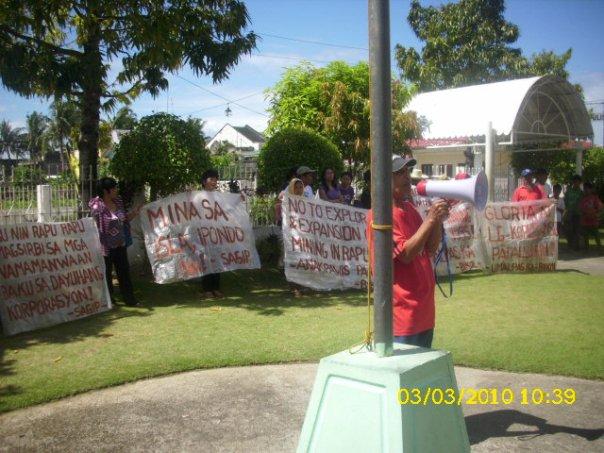
CIRCA flaunts the Ten Commandments of Climate Change
Commandment Number 7 states: Thou shall not resort to open pit mining . . . to avert climate change. Notice the photo of the CIRCA Executive Director at lower left.
CIRCA Defies SARA Boycott Call
Though blurred, the LG label is still visible on the flat screen.
Evidence that Nong Rangasa suggested to invite mining companies to his LGU Summit + 3i exhibit
Excerpt from the minutes of the meeting on October 11, 2010
